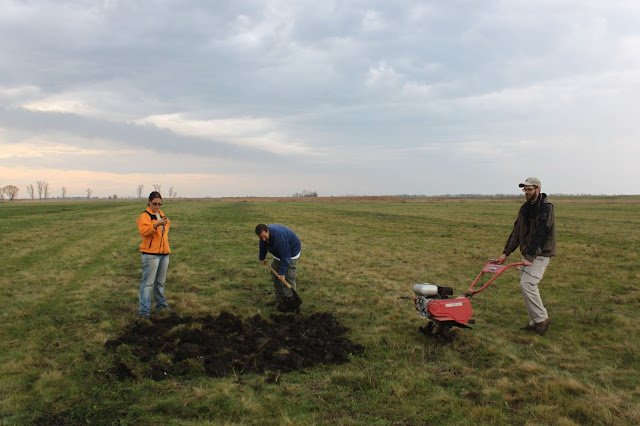Our paper, first-authored by Réka Kiss, about establishment gaps has recently been accepted in Restoration Ecology. Please click here to download the pdf.
Kiss, R., Deák, B., Tóthmérész, B., Miglécz, T., Tóth, K., Török, P., Lukács, K., Godó, L., Körmöczi, Zs., Radócz, Sz., Kelemen, A., Sonkoly, J., Kirmer, A., Tischew, S., Švamberková, E., Valkó, O. (2020): Establishment gaps: biodiversity hotspots to support the colonization of target species in species-poor grasslands. Restoration Ecology doi: 10.1111/rec.13135 [IF2018: 2.826]
What are establishment gaps and what are they used for?
Kiss, R., Deák, B., Tóthmérész, B., Miglécz, T., Tóth, K., Török, P., Lukács, K., Godó, L., Körmöczi, Zs., Radócz, Sz., Kelemen, A., Sonkoly, J., Kirmer, A., Tischew, S., Švamberková, E., Valkó, O. (2020): Establishment gaps: biodiversity hotspots to support the colonization of target species in species-poor grasslands. Restoration Ecology doi: 10.1111/rec.13135 [IF2018: 2.826]
What are establishment gaps and what are they used for?
Soil seed bank can be a source of species which contribute to the spontaneous recovery of grasslands; however, its restoration potential is often limited because there are lot of grassland species, which have no persistent seed bank. Therefore, in severely degraded areas we cannot rely on spontaneous grassland recovery solely from the seed bank. This propagule limitation can be aggravated by the lack of seed rain of target grassland species due to their low dispersal ability and the lack of source populations in intensively used landscapes. Besides propagule limitation, favourable niches for the establishment of grassland species are also limited in perennial-dominated, dense grassland swards. Both the accumulation of living and dead biomass and the encroachment of competitor species can hinder germination and establishment of grassland species. Propagule and microsite limitation together halt the spontaneous recovery of species-rich grasslands and their effect generally increases with the time elapsed since the beginning of the degradation. The success of restoration activities can be enhanced by overcoming the above mentioned two major limitations, by propagule addition to the target area (e.g. seed sowing, hay and topsoil transfer), and by provision of microsites either by natural (animal perturbations or grazing by wild animals) or human-induced (mowing, tilling, grazing by livestock) disturbances. Such gaps have reduced competition which is important especially in the early and most vulnerable stages of plant establishment.
The idea of using ‘establishment gaps’ for increasing the plant diversity of species-poor grasslands is based on reducing the microsite limitation by opening gaps in the sward and by overcoming propagule limitation by sowing seeds of target species in the openings. We developed and tested the method during the Pro-Seed DBU project and wrote about the first results here.
How can we create establishment gaps?
We used tillage to open gaps of 1-m2, 4-m2 and 16-m2 size in the dense grass sward of six species-poor restored grasslands in the Great Hungarian Plain. We sowed high-diversity seed mixtures of 35 native species into all gaps.
How can we create establishment gaps?
We used tillage to open gaps of 1-m2, 4-m2 and 16-m2 size in the dense grass sward of six species-poor restored grasslands in the Great Hungarian Plain. We sowed high-diversity seed mixtures of 35 native species into all gaps.
 |
| The first step: We create the gap by tilling and opening up the dense sward in small patches. This can be a very hard work on the compact alkaline soils which are characteristic at our study site. |
 |
| We harvested seeds of species typical to alkaline and loess grasslands and compiled a diverse seed mixture of 35 species. We sowed this seed mixture at a density of 100 kg/ha in the gaps. |
Our results indicated that most of the sown species were able to establish permanently in the gaps. The total cover and the cover of perennial sown species increased and the cover of short-lived sown species decreased independently of gap size. There was only a moderate level of weed abundance in the gaps, and weed cover decreased over the years. The sown target species started to colonize the species-poor grasslands surrounding the gaps within five years. The highest number of species and individuals dispersed from the medium-sized gaps, as they had a more stable development than smaller gaps and were exposed to lower grazing pressure than large ones.
Small gaps were less effective in supporting establishment and colonization of sown species than the large- and medium-sized ones. However, contrary to our expectations, not the largest establishment gaps were the most effective but the medium-sized ones. The medium-sized gaps supported the highest species number per colonization plot, the highest number of individuals, the highest number of flowering species, and the highest total number of flowering shoots. We found that vegetation development and establishment of sown species is rather stochastic in the small gaps. Recolonization by grasses is the most likely in the small gaps with low surface:perimeter ratio, which hinders the establishment and colonization of sown species. Thus, larger gaps are more stable and less susceptible to grass recolonization and provide more favourable conditions for sown species to persist.
Our results suggest that establishment gaps are a widely applicable tools to increase the diversity of species-poor grasslands. Gaps of a few square meters represent a more feasible solution compared to larger openings also for the farmers, because there is only a moderate level of weed encroachment and smaller soil disturbance occurs during their creation. The creation of the gaps does not require heavy machinery, it can be done with basic gardening equipment. The most expensive and labour-intensive part is the compilation of the seed mixture. However, given the small size of the gaps, the necessary amount of seed mixture can be collected within a few days if the donor sites are available in the region.



